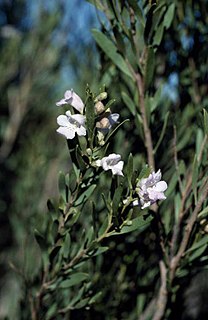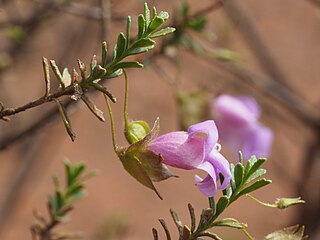Eremophila koobabbiensis, commonly known as Koobabbie eremophila, is a flowering plant in the figwort family, Scrophulariaceae and is endemic to Western Australia. It is an erect shrub with hairy branches, pale green leaves and lilac to pale mauve flowers. It is only known from a single farm where there were 96 mature plants in 2010, but specimens grown from cuttings survive in Victoria (Australia) and South Australia, as well as in Kings Park, Perth.

Eremophila magnifica is a flowering plant in the figwort family, Scrophulariaceae and is endemic to Western Australia. It is an erect shrub with large, clustered leaves and large, attractive lilac-coloured or purple flowers, sometimes so densely clustered that they appear like compound heads of terminal flowers.

Eremophila paisleyi is a plant in the figwort family, Scrophulariaceae and is endemic to Australia. It is a rounded, broom-shaped shrub with white or lilac-coloured flowers which occurs in Western Australia, South Australia and the Northern Territory.
Eremophila pallida is a flowering plant in the figwort family, Scrophulariaceae and is endemic to Western Australia. It is a small, spreading shrub with hairy stems, leaves with a few serrations and reddish purple to violet flowers.
Eremophila papillata is a flowering plant in the figwort family, Scrophulariaceae and is endemic to Western Australia. It is an erect, compact shrub with sticky, narrow leaves and mauve, blue or purple, rarely white flowers.
Eremophila pendulina is a flowering plant in the figwort family, Scrophulariaceae and is endemic to Western Australia. It is a tall, spindly, weeping shrub with narrow leaves and purple, mauve or white flowers in autumn and early spring.
Eremophila petrophila is a flowering plant in the figwort family, Scrophulariaceae and is endemic to Western Australia. It is a tall, erect, open shrub with rough branches, narrow, sticky leaves and pale lilac-coloured flowers.

Eremophila phyllopoda is a flowering plant in the figwort family, Scrophulariaceae and is endemic to Western Australia. It is an erect or spreading shrub, sometimes round or flat-topped with sticky, hairy leaves and flowers ranging in colour from pink or lilac to purple.

Eremophila punctata is a flowering plant in the figwort family, Scrophulariaceae and is endemic to Western Australia. It is an erect shrub with sticky young branches and leaves due to the presence of resin. Its small leaves usually have a few blunt teeth near their ends and flowers which are usually lilac-coloured. It is a distinctive and widespread species.
Eremophila pungens is a flowering plant in the figwort family, Scrophulariaceae and is endemic to Australia. It is an erect, sticky shrub with broad, serrated-edged leaves which end in a sharp spine and purple or violet flowers.

Eremophila recurva is a flowering plant in the figwort family, Scrophulariaceae and is endemic to Australia. It is a shrub with hairy grey leaves, large grey sepals and blue, mauve or lilac flowers.
Eremophila revoluta is a flowering plant in the figwort family, Scrophulariaceae and is endemic to Western Australia. It is a low, dense shrub with small, hairy leaves, very hairy sepals and mauve or purple petals.

Eremophila rhegos is a flowering plant in the figwort family, Scrophulariaceae and is endemic to Western Australia. It is an erect shrub with densely hairy leaves and branches and blue, mauve, purple or white flowers.

Eremophila rigens is a flowering plant in the figwort family, Scrophulariaceae and is endemic to Western Australia. It is an erect shrub with long, stiff, glabrous leaves and pale lilac-coloured to white flowers.

Eremophila rigida is a flowering plant in the figwort family, Scrophulariaceae and is endemic to Western Australia. It is an erect, rigid shrub with thick, hairy, rigid leaves and pale yellowish-cream flowers.

Eremophila sargentii is a flowering plant in the figwort family, Scrophulariaceae and is endemic to Western Australia. It is a shrub with sticky, shiny foliage, small leaves and mauve or blue flowers.
Eremophila shonae is a flowering plant in the figwort family, Scrophulariaceae and is endemic to Western Australia. It is an erect shrub or a low spreading shrub, depending on subspecies and has very sticky branches and leaves due to the presence of large amounts of resin. The leaves are narrow and the flowers are mauve to purple and white inside with purple spots.
Eremophila succinea is a flowering plant in the figwort family, Scrophulariaceae and is endemic to Western Australia. It is an erect, broom-shaped shrub with sticky, narrow, hooked leaves, narrow, sticky sepals and hairy, pale purple or mauve petals.
Eremophila viscimarginata is a flowering plant in the figwort family, Scrophulariaceae and is endemic to Western Australia. It is a small, erect, prickly shrub with hairy stems, small leaves, greenish-pink sepals and mauve petals.

Eremophila warnesii is a flowering plant in the figwort family, Scrophulariaceae and is endemic to Western Australia. It is an erect, compact shrub with furry leaves, hairy sepals and blue to mauve petals. It is a little-known species, named after the founder of the Eremophila Study Group.











